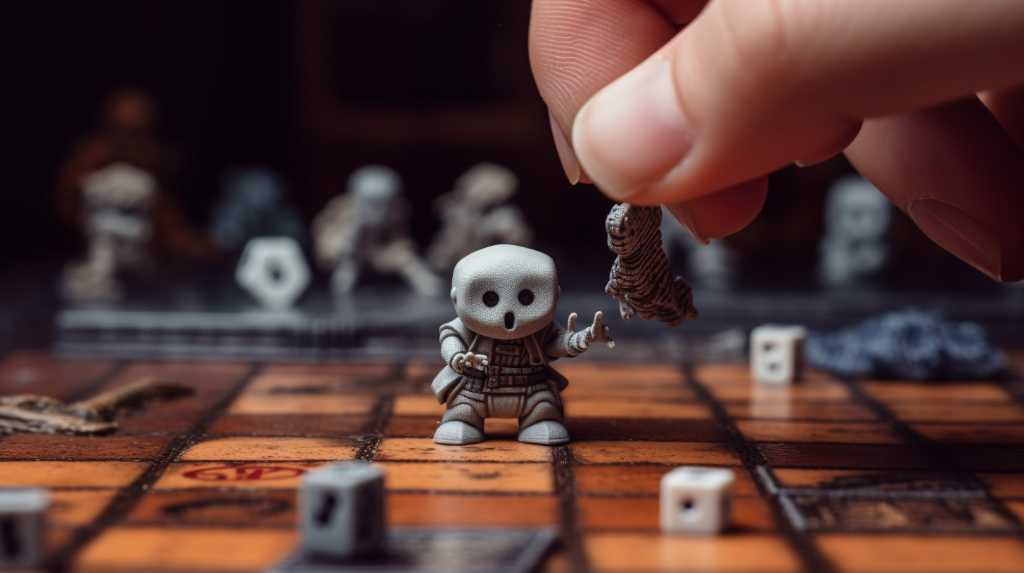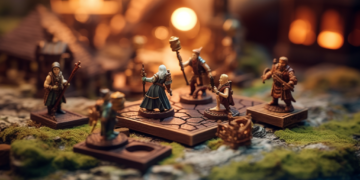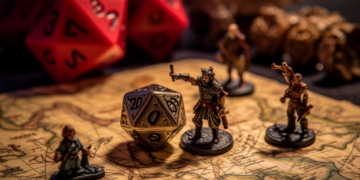
Imagine the creeping dread as you navigate through a dimly lit dungeon, your heart pounding in sync with the drip-drop of water echoing eerily off stone walls. Suddenly, a horrifying figure lurches from the shadows, its chilling presence sending a wave of fear through your party. This isn’t just any foe – this is a Ghast. These abominable creatures, with their unique abilities and terrifying tactics, can turn a delightful quest into a nightmare of epic proportions. Understanding the Ghast’s abilities, stats, and tactics can elevate your Dungeons and Dragons experience, transforming an encounter from a simple battle to a thrilling test of strategy and survival.
The Dreadful Anatomy of a Ghast 5e
What makes a Ghast so horrific? Is it its towering size, the unnatural strength that belies its skeletal form, or the predatory features that speak of a hunger never sated? A Ghast’s physical attributes are the stuff of nightmares, a gruesome blend of death and malice that strikes fear in the hearts of even the most seasoned adventurers.
Unraveling the Ghast’s Sinister Abilities
Perhaps the most terrifying aspect of a Ghast 5e is its unique abilities. The Ghast possesses two particularly chilling special abilities – ‘Stench’ and ‘Paralysis.’ The ‘Stench’ ability, a ghastly aura that surrounds the creature, can make those nearby retch with discomfort. The ‘Paralysis’ ability, on the other hand, can freeze an adventurer in their tracks, leaving them helpless before the Ghast’s onslaught. Understanding how these abilities function can be the difference between life and death in the game.
Ghast 5e: An Overview of Stats
While a Ghast’s abilities are fearsome, its stats are equally daunting. With a respectable pool of hit points and a speed that belies its undead nature, the Ghast is a formidable opponent. But it’s the creature’s Strength and Dexterity scores that truly shine, making it a lethal adversary in close-quarters combat. Familiarizing oneself with these stats is crucial for anyone hoping to survive an encounter with a Ghast 5e.
Tactics: Making the Most of a Ghast 5e’s Powers
In the shadowy realm of Dungeons and Dragons, mastering the art of tactical combat is as crucial as a well-stocked inventory. When faced with a Ghast, the Dungeon Master’s strategy can mean the difference between a memorable encounter and a tiresome battle. So, how does one wield the chilling powers of a Ghast to their advantage?
First, let’s remember that a Ghast is not just a mindless monster. It’s a cunning predator, a creature that thrives in the darkest corners of the dungeon, using its horrifying abilities to ambush, paralyze, and devour its prey.
Turning the Stench Ability into a Strategic Advantage
Ever wondered how the Ghast’s stench ability could turn the tide of a battle? This unnerving ability, as vile as it may be, can be a potent weapon in a Dungeon Master’s arsenal. It’s not just about the immediate reaction it elicits from the players; it’s about how it can disrupt their strategies and force them to think on their feet.
Imagine the scene: The party enters a room, their torches barely piercing the all-encompassing darkness. Suddenly, a wave of unspeakable odor washes over them, turning their stomachs and weakening their resolve. And then, from the shadows, the Ghast attacks. It’s not just an encounter anymore; it’s a test of endurance, a battle against their own senses. Isn’t that a thrilling thought?
Mastering the Art of Paralysis
Now, let’s delve into the Ghast’s most fearsome ability: Paralysis. Have you ever considered the sheer terror of being unable to move while a monstrous creature looms over you? That’s the power of the Ghast’s paralysis ability. It’s not just about immobilizing a character; it’s about sowing fear and panic among the party.
As a Dungeon Master, you can use this ability to isolate characters, disrupt their plans, and create moments of genuine fear. Remember, Dungeons and Dragons is not just about combat; it’s about storytelling. And what better way to tell a story than to put your characters in the direst of situations?
Surviving a Ghast Encounter: Tips for Players
But fear not, brave adventurers! A Ghast encounter, while daunting, is not a death sentence. With the right strategy, a dash of courage, and a bit of luck, you can outsmart this horrifying creature and live to tell the tale. So, how do you survive a Ghast encounter?
Essential Tips to Overcome Ghast’s Stench
First, let’s tackle the stench. It’s vile, it’s potent, and it’s enough to make even the bravest warrior retch. But it’s not unbeatable. Consider using spells or items that can counteract the effects of the stench. Abilities that boost your constitution or provide resistance to poison can be invaluable in this situation. And remember: teamwork is key. Use your party’s strengths to your advantage and support each other through the ordeal.
Strategies to Resist Ghast’s Paralysis
Now, the paralysis. This is where things get tricky. A paralyzed character is a vulnerable character, and in the heat of battle, vulnerability can be fatal. But there are ways to counteract this dreaded ability. Spells that grant immunity or resistance to paralysis can be a lifesaver in this situation. And don’t forget about your party members. A well-timed spell or a swift attack can disrupt the Ghast’s focus and free a paralyzed character. But above all, remember: a successful adventurer is a prepared adventurer.
Roleplaying a Ghast: Tips for DMs
Have you ever wondered how to bring the terrifying presence of a Ghast to life in your campaign? The key lies not only in understanding its abilities and stats but also in mastering the art of role-playing this dread-inducing creature. Remember, the Ghast is not just a monster with high hit points and deadly abilities; it is a creature that thrives in the darkness, instilling fear and chaos among its victims.
As a Dungeon Master, your role is to embody the essence of the Ghast. Imagine the Ghast’s predatory gait, its bone-chilling growl, and its paralyzing gaze. Use vivid descriptions to create a palpable sense of dread. The moment your players step into its lair, they should feel a chill run down their spines as they sense the lurking danger.
Don’t forget to exploit the Ghast’s abilities for maximum effect. The vile stench that precedes its arrival, the debilitating paralysis it inflicts on its victims – these are not just game mechanics, but powerful tools for setting the scene and heightening the tension.
Ghastly Lore: The Origin & History of Ghasts
Now that we’ve covered the practical aspects of handling a Ghast, let’s delve into the rich lore of these terrifying creatures. What are their origins? What’s their history in the Dungeons and Dragons universe? Understanding this can add another layer of depth to your campaign and make encounters with a Ghast even more engaging.
The Ghasts were born out of the abyss, a manifestation of the primal fear and chaos that lurk in the darkest corners of the universe. Their existence is a testament to the corrupting influence of the abyss, as they were once ordinary ghouls twisted and warped into something far more horrifying.
The history of the Ghasts is entwined with the tales of dread and horror. They are whispered about in hushed tones and are often the embodiment of nightmares that plague the brave and the foolhardy who dare to venture into the darkness.
Keep in mind, this lore can be used to enhance the atmosphere of your campaign. Perhaps your players find an ancient tome detailing the origin of Ghasts, or they encounter a survivor from a previous Ghast attack, their sanity shattered by the horrific experience. Using the lore in this way can make the presence of a Ghast in your campaign more than just a combat encounter – it becomes a harrowing tale of survival against a horrifying embodiment of fear and chaos.
Ghast Companions and Foes: Notable Encounters
Every adventurer knows that a Ghast seldom roams alone. These terrifying creatures are often found in the company of equally horrifying creatures, adding another layer of complexity to the encounter. But who are these creatures exactly?
One of the most common companions of a Ghast is the Ghoul. These insatiable flesh eaters share a common origin with the Ghast, making them a fitting partner in crime. A dungeon master can add an extra layer of difficulty to an encounter by having a Ghoul accompany a Ghast. The combination of their abilities can create a truly grueling challenge for players.
But what about the foes of a Ghast? Interestingly, the Ghast’s most formidable foes are often Paladins and Clerics, or any class capable of turning undead. These classes can use their divine powers to repel or destroy Ghasts, making them a beacon of hope in the face of such dread.
Conclusion: The Worth of Knowing Your Ghast 5e
So, why should you bother learning about the Ghast 5e? The answer is simple: knowledge is power. Understanding the Ghast’s abilities, stats, and tactics can greatly enhance your gaming experience, whether you’re a player trying to survive an encounter or a dungeon master trying to challenge your players.
Knowing your enemy can turn a potentially deadly encounter into a thrilling battle of wits and strategy. It can transform a simple dungeon crawl into a memorable adventure. So, next time you face a Ghast, won’t you be glad you took the time to understand it?
Key Points
- Ghasts are often accompanied by Ghouls, adding an extra layer of difficulty to encounters.
- Paladins and Clerics are particularly effective against Ghasts due to their ability to turn undead.
- Understanding a Ghast’s abilities, stats, and tactics can enhance gameplay for both players and dungeon masters.
Ghast 5e: A Summary
| Ability | Stats | Tactics |
|---|---|---|
| Stench | Hit Points: Average | Often used to weaken opponents before attacking |
| Paralysis | Speed: Fast | Used strategically to immobilize players |
| N/A | Strength: High | N/A |
| N/A | Dexterity: Average | N/A |






